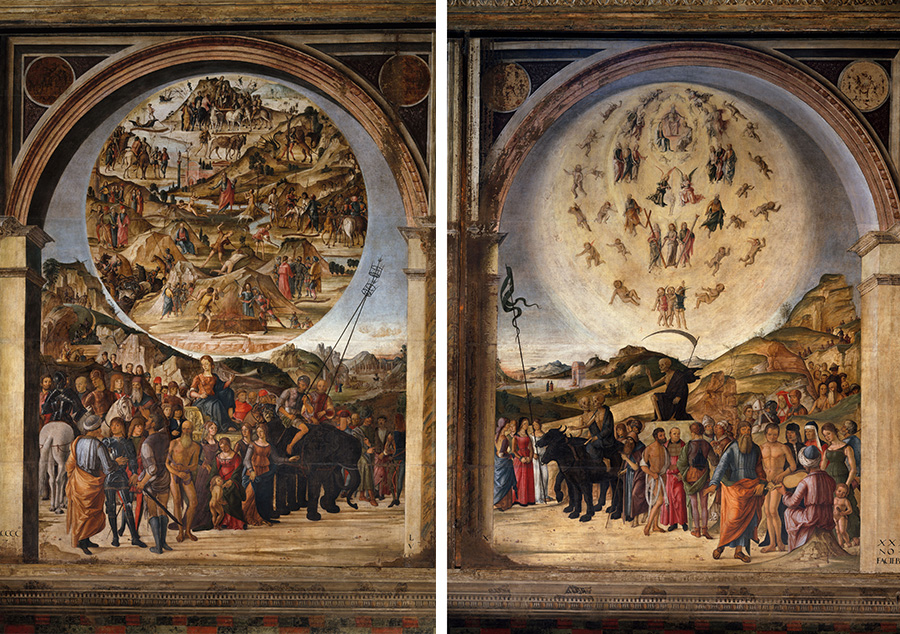Gloria de Liberali
The Bentivoglio Triumphs: A Visual Poem in Renaissance Bologna

Lorenzo Costa, The Triumph of Fame; The Triumph of Death, 1490, tempera on canvas, Bentivoglio Chapel, Bologna. Photos: Scala / Art Resource, NY
In 1490 the Italian artist Lorenzo Costa created two paintings for the Bentivoglio Chapel, a private space in the church of San Giacomo Maggiore in Bologna under the patronage of Giovanni II Bentivoglio, then de facto lord of Bologna. In these images, allegorical personifications and historical figures can be seen alongside portraits of past and present members of the Bentivoglio house parading around two triumphal chariots inspired by Petrarch’s poem titled Triumphi (the Triumphs), while the backgrounds host scenes from Dante’s imaginary journey through Hell and Purgatory in The Divine Comedy, and the skies are filled with ancient narratives and celestial visions. By conflating imagery drawn from Trecento poetry, classical mythology, ancient history, and Christian philosophy, Costa’s Bentivoglio Triumphs disrupt our expectations about Renaissance church decorations and force us to reconsider the place of poetry and history within Christian theology and art at the dawn of the Renaissance.
Most recently, I have focused on the relationship between the Bentivoglio Triumphs and Petrarch’s Triumphi and completed an article that reexamines Costa’s diptych through the lens of the religious syncretism that characterized 15th-century Italian culture. While most of the artistic illustrations of Petrarch’s poem created in the Quattrocento were endowed with political and military overtones, I argue that Costa’s diptych represents the first instance where a Christian-allegorical interpretation of the Triumphi informed an artistic depiction of that Petrarchan subject instead. That interpretation was first introduced in literature by Bernardo di Pietro Lapini, a humanist doctor whose Comento ai Triumphi (Commentary to the Triumphs) was published in its editio princeps in Bologna in 1475. Lapini understood the Petrarchan poem in a Christian perspective as a universal metaphor for the progress of the human soul, from youth to the eternal afterlife. My study shows that some of Costa’s unique artistic choices, such as the extrapolation of Fame and Death from the Petrarchan series, the inclusion of a figure representing a Bentivoglio soul ascending toward a divine assembly, and the symmetry and complementarity built into the two scenes, stem from Lapini’s allegorization of the poem while also serving the funerary purpose of the chapel that the paintings adorn.
This year, I have also begun new research on three objects in the National Gallery’s collection that feature the likeness of Ginevra Sforza Bentivoglio, wife of Giovanni II, who is at the center of my next project.
